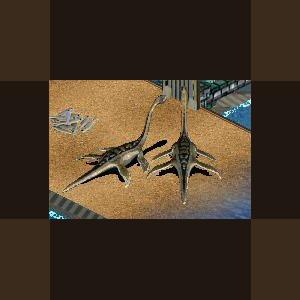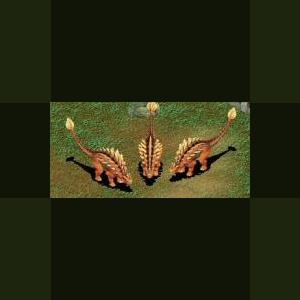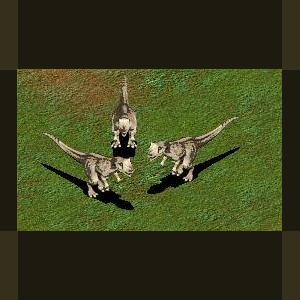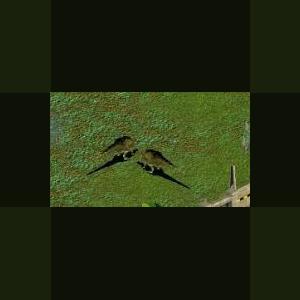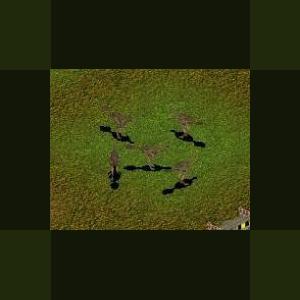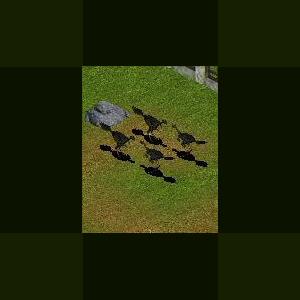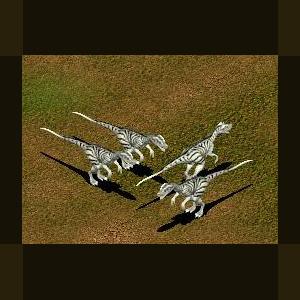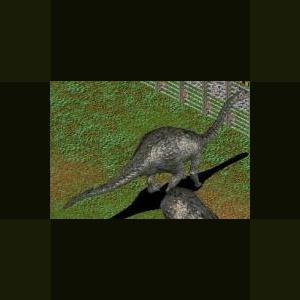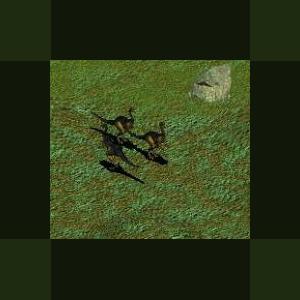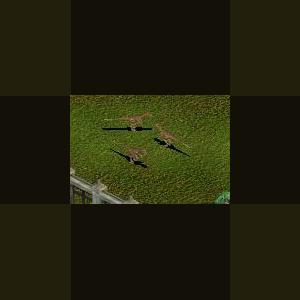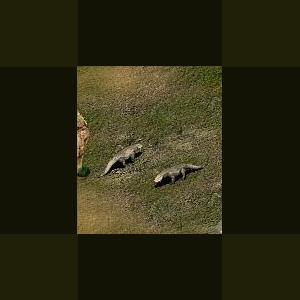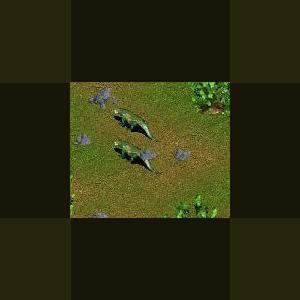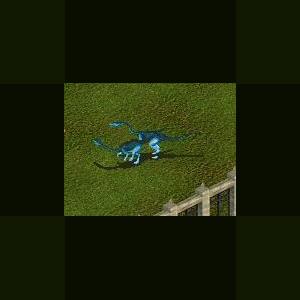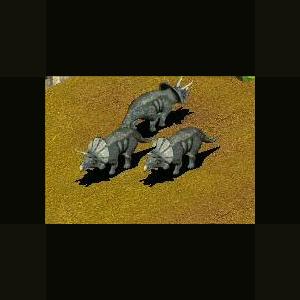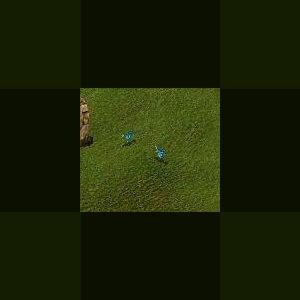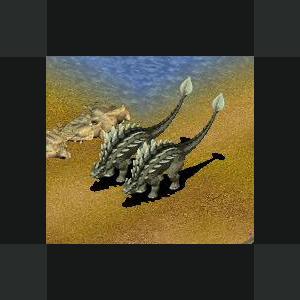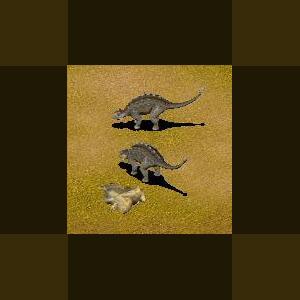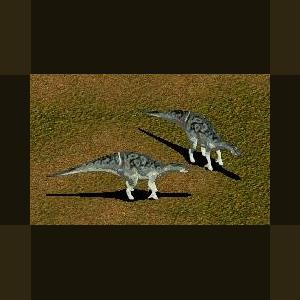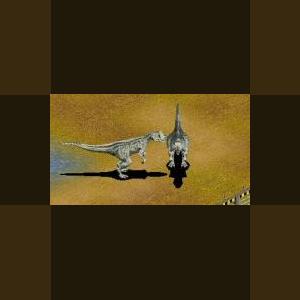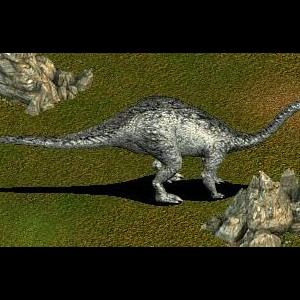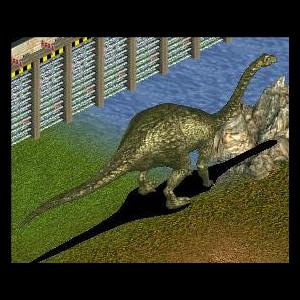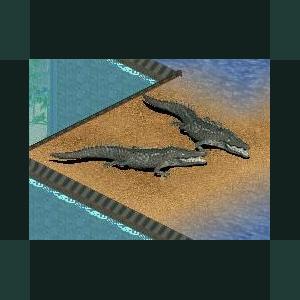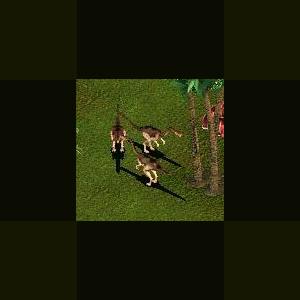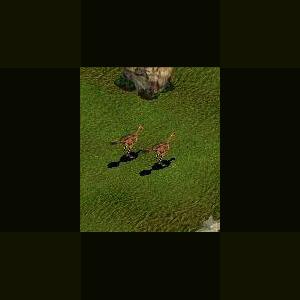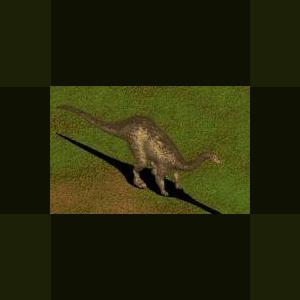Dinosaurs
Creatures from another age
241 files
-
Futabasaurus Suzukii by Moondawg
By Guest
Futabasaurus Suzukii is the name of a plesiosaur that was described in 2006 by Sato, Hasegawa, and Manabe.
Futabasaurus comes from the Late Cretaceous of Fukushima, Japan, and was assigned to the family Elasmosauridae.
The name Futabasaurus also appears in connection with a theropod dinosaur, also from the Late Cretaceous of Japan. However, this dinosaur was not officially named, so the name Futabasaurus is a nomen nudum when applied to this theropod. It is not the same as the plesiosaur named Futabasaurus.
342 downloads
0 comments
Updated
-
Euoplocephalus by Moondawg
By Guest
It has been said that the herbivores and carnivores forced each other to evolve in a rapid escalating battle of armor vs. firepower.
If this is the case, and it seems very likely it is, then a very successful biological armored vehicle was Euoplocephalus.
Pronounced you-op-luh-SEF-uh-lus the name means "well protected head. This tank-like creature was from the late Cretaceous and is in the Ankylosaur family. It was believed to weigh in the 3 to 5 ton range and averaged 20 feet in length and maybe 8 or 9 feet in width.
What is unusual is that this heavily armored dinosaur was very likely totally immune to the attack of the large carnivores like T rex. It's strategy may well have been to first try and use it's bony and spiked tail to dissuade its attacker and then if that didn't work to simply hanker down in the sand or earth, protect its head and just out wait its adversary. As a side note there have been T rex leg bones found that were fractured in just the manner that Euoplocephalus would have done if it connected in a fight.
This species was the long end product of a very successful weeding out of less successful creatures. If it was for the Extinction Event that took out all of the dinosaurs this creatures descendants may well have been alive to this day. That is if the plants continued to survive. At this time (app. 70 MYA) we would have found cycads, tree ferns, bonze pines, katsura trees, and large conifers. but perhaps the defining tree would have been the bald cypress. These plants only thrived in humid and warm conditions and this is where these armored dinosaurs would have flourished.
Inspired by the Zoo Tek Brains Trust
231 downloads
0 comments
Updated
-
Megaraptor by Moondawg
By Guest
Megaraptor ("giant thief") was once thought to be the largest dromaeosaur ever found, but is now known to be a carnosaur related to Allosaurus.
It lived in Late Cretaceous times in the Patagonian region of Argentina. It was a contemporary of Giganotosaurus, one of the largest carnivorous dinosaurs of all time.
Megaraptor was initially described as a giant dromaeosaur, known primarily from a single claw (about 1ft long) that resembled the sickle-shaped foot claw of dromaeosaurids. The discovery of a complete front limb, however, showed that this giant claw actually came from the first finger of the hand. The hands were unusually elongated, bore sickle-shaped claws even more recurved than those of spinosaurids.The hand is quite distinct from other basal tetanurans, so it is not clear whether Megaraptor is an allosaurid, a carcharodontosaurid, a spinosauroid, or something else entirely.
It should be noted that, when first discovered and prior to publication, the spinosaurid Baryonyx was also reported to be a dromaeosaurid, again based on a large hand claw.
Megaraptor's size is debated. However, most experts have come to agree that Megaraptor is approximately 8 meters (26 feet) in length and 3 meters (10 feet) in height.
179 downloads
0 comments
Updated
-
Hadrosaurus by Moondawg
By Guest
Hadrosaurus (hadros + sauros = sturdy lizard) is a dubious genus of hadrosaurid dinosaur.
In 1858, a skeleton of a dinosaur from this genus was the first full dinosaur skeleton found in North America and, in 1868, it became the first ever mounted dinosaur skeleton. Hadrosaurus foulkii is the only species in this genus and has been the official state dinosaur of New Jersey since 1991.
Hadrosaurus lived near what is now the coast of New Jersey, U.S.A., in the late Cretaceous Period - around 80 million years ago. It was likely bipedal for the purposes of running, but could use its forelegs to support itself while grazing - like all hadrosaurids, Hadrosaurus was herbivorous. Its teeth suggest it ate twigs and leaves
Hadrosaurus lived near what is now the coast of New Jersey, U.S.A., in the late Cretaceous Period - around 80 million years ago. It was likely bipedal for the purposes of running, but could use its forelegs to support itself while grazing - like all hadrosaurids, Hadrosaurus was herbivorous. Its teeth suggest it ate twigs and leaves.
In 1838, William Estaugh Hopkins was digging in a marl pit (on a small tributary of the Cooper River in Haddonfield, New Jersey) when he uncovered large bones, putting them on display at his home, also in Haddonfield. In 1858 these bones sparked the interest of a visitor, William Parker Foulke. The skeleton was dug out from the marl pit in 1858 by Foulke. In the same year, the species was named by paleontologist Joseph Leidy from an almost complete set of limbs, along with a pelvis, several part of the feet, twenty-eight vertebrae (including eighteen from the tail), eight teeth and two small parts of the jaw. Leidy recognized that these bones were from a dinosaur by their similarity to those of Iguanodon, discovered in England some decades before, but the skeleton of Hadrosaurus was far more complete. Leidy's monograph Cretaceous Reptiles of the United States, describing Hadrosaurus more completely and with illustrations, was written in 1860 but the American Civil War delayed its publication until 1865. Leidy reconstructed Hadrosaurus as a biped, in contrast to the view at the time that such dinosaurs were quadrupedal. The entire skeleton was completely assembled in 1868 by a team including English sculptor and naturalist Benjamin Waterhouse Hawkins and was put on display at Philadelphia Academy of Natural Sciences, where it remains available for public viewing.
248 downloads
0 comments
Updated
-
Beipiaosaurus by Moondawg
By Guest
Beipiaosaurus is a genus of therizinosauroid theropod dinosaur.
The discovery of Beipiaosaurus , which translates as "Beipiao lizard" after a city in China near the location of its discovery, was announced in the May 27, 1999, issue of the journal Nature. These fossils were found in Liaoning Province, China and have been dated to the early Cretaceous Period, about 125 million years ago. It is known from a single species, B. inexpectus, named for "the surprising features in this animal.". A significant number of fossilized bones for this species were recovered, including: cranial fragments, a mandible, three cervical vertebrae, four dorsal vertebrae, a caudal vertebra, the scapula and scapulacoracoid, a complete forelimb, and a complete pelvis with hindlimb.
The exact classification of therizinosaurs had in the past been hotly debated, since their prosauropod-like teeth and body structure indicate that they were generally herbivorous, unlike typical theropods. Beipiaosaurus, being considered to be a primitive therizinosauroid, has features which suggest that all therizinosauroids, including the more derived Therizinosauridae, to be coelurosaurian theropods, not sauropodomorph or ornithischian relatives as once believed.
Beipiaosaurus measured 2.2 meters (7.3 ft) in length and .88 meters (2.9 ft.) tall at the hip, and is among the largest known feathered dinosaurs. Its weight is estimated as about 85 kg (187 lb.) Beipiaosaurus had a toothless beak with cheek teeth. More advanced therizinosaurids have four functional toes, but the feet of Beipiaosaurus' have reduced inner toes, showing that the derived therizinosaurid condition may have evolved from a three-toed therizinosauroid ancestor. The head was large relative to other therizinosaurs, and it had some features similar to the related oviraptorosaurs. The fossil's skin impressions indicate its body was covered by downy feather-like fibers, which are similar to those of Sinosauropteryx, but longer, and are oriented perpendicular to the arm. Xu et al. suggest that the feathers of Beipiaosaurus represent an intermediate stage between Sinosauropteryx and more advanced birds (Avialae). As only theropod dinosaurs are so far known to have been feathered, this discovery is further evidence that therizinosaurs were indeed theropods.
215 downloads
0 comments
Updated
-
Hagryphus by Moondawg
By Guest
Hagryphus
Hagryphus ("Ha's griffin", from Egyptian Ha, name of a god of the western desert and Greek gryphus meaning 'griffin' (a mythological bird-like creature); Zanno and Sampson, 2005) is an oviraptorosaurian theropod dinosaur from the Upper Cretaceous Period of what is now Utah.
To date, only a single species is known, H. giganteus. The holotype was discovered in the Kaiparowits Formation (Late Campanian) in the Grand Staircase-Escalante National Monument of southern Utah. Radiometric dating indicates that the beds where the specimen was found date to between 76 and 75 million years ago. Designated UMNH VP 12765, the type specimen resides in the collections of the Utah Museum of Natural History in Salt Lake City. It consists of an incomplete but articulated left manus and the distal portion of the left radius. Both the semilunate and radiale are preserved.
Other known species of North American oviraptorosaurs include Elmisaurus rarus, Microvenator celer, and Chirostenotes pergracilis. This group of dinosaurs is better known from the Cretaceous of Asia, where forms such as Khaan mckennai, Conchoraptor gracilis and Oviraptor philoceratops have been discovered.
Oviraptorosaurs are characterized by a shortened snout, massive endentulous jaws and extensively pneumatized skulls, often sporting elaborate crests, the function of which remains unknown. The toothless jaws may indicate a diet of eggs but these theropods likely fed on small vertebrates as well. Evidence suggests that they were feathered and some paleontologists consider them to be true birds (see the main article Oviraptorosauria for further information).
As the species name indicates, Hagryphus giganteus was a particularly large oviraptorosaur, estimated to have been approximately 3 meters (10 ft) long, which makes it one of the largest members of the clade Oviraptorosauria (Barsbold, 1976). H. giganteus is estimated to be 30-40% larger than the next largest known North American oviraptorosaur, Chirostenotes.
173 downloads
0 comments
Updated
-
Guaibasaurus by Moondawg
By Guest
Guaibasaurus (meaning "Guaiba Lizard") was a basal Saurischian dinosaur which lived during the Triassic.
Its fossils were found in state of Rio Grande do Sul, Brazil. Like Herrerasaurus, this dinosaur had three full fingers, and two vestigial ones on each hand.
The type species, G. candelariai, was described by Jose Bonaparte and J. Ferigolo in 1998
146 downloads
0 comments
Updated
-
Quaesitosaurus by Moondawg
By Guest
Quaesitosaurus ('extraordinary lizard') is a Cretaceous titanosaurian sauropod (the last of this order) found by Kurzanov and Bannikov in 1983.
The type species is Quaesitosaurus orientalis. Quaesitosaurus grew to 23 meters long. It lived from 80 to 65 million years ago.
Quaesitosaurus (meaning "extraordinary lizard") is a genus of titanosaurian sauropod found by Kurzanov and Bannikov in 1983. The type species is Quaesitosaurus orientalis. Quaesitosaurus grew to 23 meters long. It lived from 85 to 70 million years ago during the Late Cretaceous (Santonian to Campanian ages). Its fossils, consisting solely of a partial skull, were found in the Barun Goyot Formation near Shar Tsav, Mongolia. Long, low and horse-like with frontally located peg-teeth, it is similar enough to the skulls of Diplodocus and its kin to have prompted informed speculation that the missing body was formed like those of diplodocids.
It is possible that Nemegtosaurus, also known from only skull material, is a very close relative of Quaesitosaurus, if not indeed a variation of the same animal.
135 downloads
0 comments
Updated
-
Dromiceiomimus by Moondawg
By Guest
Dromiceiomimus (meaning "Emu mimic") was a swift bipedal dinosaur from the late Cretaceous period, about 80 to 65 million years ago
It was about 12 feet (3.5 m) long and weighed about 220 to 330 pounds (100 to 150 kg). Its femur (thigh bone) was 468 mm long. This ornithomimid (a bird-like theropod) had very long limbs, hollow bones, and a large brain and eyes. It had a toothless, beaked mouth, and weak jaws.
The brains of ornithomimids were large for dinosaurs, but this may not necessarily be a sign of greater intelligence; some paleontologists think that the enlarged portions of the brain were dedicated to kinesthetic coordination. Compared to other ornithomimosaurs Drimiceiomimus had a short back, long slender forearms, very large eye sockets, and pelvic bones that were arranged somewhat differently.
The first fossil remains of this genus were discovered in the 1920s, and originally named Struthiomimus brevitertius and S. samueli. It was renamed by Russell in 1972 to D. brevitertius after an extensive review of North American ornithomimosaurs, which he reclassified into three genera: Dromiceiomimus, Ornithomimus, and Struthiomimus. Alberta, Canada's Horseshoe Canyon and Judith River Formations have yielded fossils of both adults and juveniles. The top speed of this dinosaur is believed to be 40 mph.
169 downloads
0 comments
Updated
-
Lycorhinus by Moondawg
By Guest
Lycorhinus angustidens is a heterodontosaurid ornithischian dinosaur hailing from the Early Jurassic strata of the Eliot Formation located in the Cape Province, South Africa.
The fossil remains consist in dentaries and maxillae hence the name that Haughton gave them in 1924, where the generic name means “wolf snout”, as it was at first misidentified as a cynodont, and the specific epithet means “constricted teeth”. Lycorhinus, including the remains described by Gow in 1975 as Lanasaurus, is a small herbivore dinosaur despite long canines it sported in its jaws; due to this unique characteristic L. angustidens is very clearly allied to Heterodontosaurus.
122 downloads
0 comments
Updated
-
Stagonolepis by Moondawg
By Guest
Stagonolepis is an extinct genus of archosaur reptile belonging to the aetosaur order. It was about 3 m (10 ft) long.
An aetosaur, Stagonolepis was a quadrupedal animal covered in thick scutes that ran down the length of the animal's body. A slow-moving browser, it used this heavy body armor to repel attacks from contemporary thecodont carnivores. Stagonolepis had a very small head for its size; it was only 25 cm (10 in), accounting for less than 10% of the total body length. It had no teeth in the front of its jaws, but a beak-like tip that arched upwards, allowing it to uproot plants (similar to how a pig uses its snout), including horsetails, ferns, and the newly evolved cycads.
Fossil remains of the animal have been found in Scotland and in South America.
This animal requires a Scientist for food and health also requires a Zookeeper to keep the exhibits clean.
184 downloads
0 comments
Updated
-
Postosuchus by Moondawg
By Guest
Postosuchus was a basal archosaur which lived in what is now North America during the middle through to the late Triassic period (228-202 million years ago).
It was a rauisuchian, a cousin of crocodiles and came from the same ancestry as dinosaurs. Its name means "crocodile from Post", named after the Post Quarry in Texas, where many fossils of the species were found. It was one of the top predators of its area during the Triassic, larger than the small dinosaur predators of its time (such as Megapnosaurus and Coelophysis). It was a hunter which probably preyed on dicynodonts and many other creatures smaller than itself.
Postosuchus was a quadrupedal reptile with a wide skull and a long tail. It was about 6 meters long, 2 meters tall, and was held up by columnar legs (a quite uncommon feature in reptiles). A crocodile-like snout, filled with many large-sized dagger-like teeth, was used to kill its prey. Rows of protective plates covering its back formed a defensive shield.
288 downloads
0 comments
Updated
-
Borogovia by Moondawg
By Guest
Borogovia was a theropod dinosaur which lived during the Late Cretaceous Period, in what is now Mongolia.
The agile carnivorous troodontid takes its name from creatures known as 'borogoves' in the Lewis Carroll poem, Jabberwocky.
Known only by partial hind limbs, the Borogovia was 2 meters (6 feet) long and weighed 13 kilograms (27 pounds).
207 downloads
0 comments
Updated
-
Torosaurus by Moondawg
By Guest
Torosaurus (meaning "perforated lizard") was a ceratopsid dinosaur genus. It had one of the largest skulls of any land animal known, reaching 8.5 feet (2.6 meters) in length.
Torosaurus belonged to the subfamily known as Chasmosaurinae, within the family Ceratopsidae, within the Ceratopsia (which name is Ancient Greek for "horned face"), a group of herbivorous dinosaurs with parrot-like beaks which thrived in North America and Asia during the Jurassic and Cretaceous Periods. Recent studies indicate that Torosaurus is most closely related to Triceratops.[3] Jack Horner has suggested in public lectures that Torosaurus may in fact represent the adult version of one sex of Triceratops, pointing out that there are no juvenile specimens of Torosaurus and that approximately 50% of all subadult Triceratops skulls have two thin areas in the frill that correspond with the placement of "holes" in Torosaurus skulls. The theory is that all Tricertops had solid frills up to adulthood, but on reaching sexual maturity, one sex or the other would have developed longer frills as a form of display. To counterbalance the extra weight of the elongated frill, holes would have necessarily developed in the bone. While this theory does explain the absence of any Torosaurus specimens younger than adults and also explains the even split between uniformly thick frills and frills with thin patches in subadult Triceratops specimens, the theory is not widely accepted in the scientific community and has apparently not been put forward by Dr. Horner outside of informal lectures.
Inspired by the Zoo Tek Brains Trust
283 downloads
0 comments
Updated
-
Sinovenator by Moondawg
By Guest
Sinovenator (meaning "Chinese - hunter", derived from the Latin word venator = hunter) is a genus of troodontid dinosaur from China.
It is from the early Cretaceous Period. Two fossils were found in the older (lower) portion of the Yixian Formation in China, 128.2 million years ago (Ma) during the Barremian age. The type specimen, Sinovenator changii, was described by Xu, Norell, Wang, Makovicky and Wu in 2002.
The type specimen is IVPP 12615, a partial skull and disarticulated skeleton. A referred specimen is IVPP 12583, an incomplete but articulated postcranial skeleton. Both are in the collection of the Institute of Vertebrate Paleontology and Paleoanthropology in Beijing China.
Sinovenator was a basal troodontid. It is the oldest and most basal described member of this family (older still but much more advanced is the yet undescribed WDC DML 001, from the Kimmeridgian-age Morrison Formation from United States). Sinovenator shares features with the most primitive dromaeosaurids and Avialae, demonstrating the common inheritance of these three members of the Paraves. Sinovenator was about the size of a chicken.
155 downloads
0 comments
Updated
-
Cedarpelta by Moondawg
By Guest
Cedarpelta is the most basal known ankylosaurid ankylosaur (Ankylosauridae; Ankylosauria), based on material recovered from the Lower Cretaceous of North America.
The skull lacks extensive cranial ornamentation, a trait which has been interpreted as plesiomorphic for ankylosaurs. Carpenter et al. (2001) diagnose Cedarpelta by the presence of a rostrocaudally elongate pterygoid with a caudolaterally oriented, trochlear-like process, a premaxilla with six conical teeth, and a straight ischium. The presence of premaxillary teeth is a plesiomorphic character because it is present in other, primitive ornithischians. In contrast, closure of the opening on the side of the skull behind the orbit, the lateral temporal fenestra, is an advanced (apomorphic) character only known in ankylosaurid ankylosaurs.
Two skulls are known, and the skull length for Cedarpelta is estimated to have been roughly 60 cm. Significantly, one of the Cedarpelta skulls was found disarticulated, a first for an ankylosaur skull, allowing paleontologists a unique opportunity to examine the individual bones instead of being limited to a cossified unit. The etymology of this binomen may be read as "Bilbey and Hall's Cedar (Mountain) shield," with the genus named for the Cedar Mountain Formation and the animal's armored plates and the species named for Sue Ann Bilbey and Evan Hall, discoverers of the type locality.
All material referrable to Cedarpelta has been recovered from the Ruby Ranch Member of the Cedar Mountain Formation. Radiometric dates place the site the specimen was collected in the (Albian) of eastern Utah.
206 downloads
0 comments
Updated
-
Gargoyleosaurus by Moondawg
By Guest
Gargoyleosaurus parkpinorum ("gargoyle lizard") is both the smallest and the earliest known ankylosaur.
Its skull measures only 29 cm in length, and its total body length is an estimated three to four meters. It may have weighed as much as a tonne. The holotype was discovered at the Bone Cabin Quarry West locality, in Albany County, Wyoming in exposures of the Upper Jurassic (Kimmeridgian to Tithonian stages) Morrison Formation.
The next earliest known ankylosaur is Minmi paravertebrata from the Aptian stage in Queensland, Australia. The type species, G. parkpinorum (originally G. parkpini) was described by Ken Carpenter et al. in 1998. A mounted skeletal reconstruction of Gargoyleosaurus parkpinorum can be seen at the Denver Museum of Nature and Science.
The holotype specimen of Gargoyleosaurus parkpinorum was collected by Western Paleontology Labs in 1996 and is currently held in the collections of the Denver Museum of Nature and Science, Denver, Colorado. Besides the holotype, two other partial skeletons are known (although not yet described) The holotype consists of most of the skull and a partial postcranial skeleton. The specimen was originally described as Gargoyleosaurus parkpini by Carpenter, Miles and Cloward in 1998, then renamed G. parkpinorum by Carpenter et al. in 2001, in accordance with ICZN art. 31.1.2A.
Much of the skull and skeleton has been recovered, and the taxon displays cranial sculpturing, including pronounced deltoid quadratojugal and squamosal bosses. The taxon is further characterized by a narrow rostrum (in dorsal view), the presence of seven conical teeth in each premaxilla, an incomplete osseous nasal septum, a linerarly arranged nasal cavity, the absence of an osseus secondary palate, and, as regards osteoderms, two sets of co-ossified cervical plates and a number of elongate conical spines.
199 downloads
0 comments
Updated
-
Naashoibitosaurus by Moondawg
By Guest
Naashoibitosaurus (meaning in Navajo na‘asho‘i "lizard creek") is a genus of hadrosaurid dinosaur that lived about 73 million years ago.
Naashoibitosaurus, based as it is on a single partial skeleton, is not well-known in terms of anatomy. Its skull, the most thoroughly described portion, has a low nasal crest that peaks in front of the eyes, but does not strongly arch as in Gryposaurus.
Naashoibitosaurus is a hadrosaurine hadrosaurid, a "flat-headed or solid-crested duckbill". It is closest to the solid-crested forms like Saurolophus. If it is the same as Kritosaurus, Kritosaurus would be used because it is the older name, but its position vis-a-vis other duckbills would be the same.
Befitting a genus with a confusing taxonomic history, the name of this genus is based on an error. David Gillette and David Thomas collected the type and only known specimen from what was thought to be the Naashoibito Member of the Kirtland Formation, the youngest member of the Kirtland; this was commemorated in the name. Instead, it came from the older, late Campanian-age De-na-zin Member. Horner described the skull in 1992 as that of an immature Kritosaurus, using it as evidence that Gryposaurus was different from Kritosaurus. At the same time, Hunt and Lucas were describing the postcrania as belonging to Edmontosaurus saskatchewanensis. When the disconnect became apparent, Hunt and Lucas gave the specimen its own generic name, because the skull did not agree with an edmontosaur, and they considered Kritosaurus indeterminate and thus not usable.
131 downloads
0 comments
Updated
-
Deltadromeus by Moondawg
By Guest
Deltadromeus ("delta runner") is a genus of theropod dinosaur from Northern Africa. This carnivore had long, unusually slender hind limbs for its size, suggesting that it was a swift runner.
It lived in the late Cretaceous Period, about 95 million years ago. It may have been one of the longest carnivorous dinosaurs, with one unpublished survey indicating that a referred partial specimen could represent an individual that was around 13.3 meters (44 ft) long, though it would have weighed only an estimated 3.5 tons, making it more slender than the giant carnosaurs. The more complete holotype specimen measured an estimated 8.1 m (26.5 ft) long. Deltadromeus skeletons have been found with those of the carnosaur Carcharodontosaurus, and it may have lived along side the even larger Spinosaurus. The specific name D. agilis, meaning "swift delta runner", comes from the fact that this species had adaptations for running, and that its remains were found in a fossilized river delta. Deltadromeus was originally described as a large coelurosaur, but more recent studies suggest it was actually a ceratosaur, possibly a gigantic member of the noasaurid family.
220 downloads
0 comments
Updated
-
Chubutisaurus by Moondawg
By Guest
Chubutisaurus was a species of dinosaur from the Early Cretaceous Period.
It lived in South America. It is classified as a Sauropod, specifically one of the titanosaurs. The type species, C. insignis, was described by del Corro in 1975.
156 downloads
0 comments
Updated
-
Supersaurus by Moondawg
By Guest
Supersaurus (meaning "super lizard") is a genus of diplodocid sauropod dinosaur discovered in the Upper Jurassic Morrison Formation of Colorado in 1972.
It is among the largest dinosaurs known from good remains, possibly reaching 33 to 34 meters (108 to 112 ft) in length, and a weight of 35 to 40 tons.
The original fossil remains of Supersaurus yielded only a few bones: the shoulder girdle (type specimen BYU 5500) and a few neck vertebrae. This shoulder girdle (or scapulocoracoid) stood some 2.4 meters (8 ft) tall, if placed on end.
A new and much more complete specimen of Supersaurus, nicknamed 'Jimbo', has been found in Converse County, Wyoming. It is currently being excavated and its bones are being held at the Wyoming Dinosaur Center. Originally, it was thought that Supersaurus was related to the long-necked diplodocid Barosaurus (a member of the subfamily Diplodocinae), but the new specimen makes it clear that Supersaurus is actually more closely related to Apatosaurus (a member of the subfamily Apatosaurinae).
202 downloads
0 comments
Updated
-
Mourasuchus by Moondawg
By Guest
Mourasuchus is an extinct genus of giant crocodilian from the Miocene of South America.
219 downloads
0 comments
Updated
-
Elaphrosaurus by Moondawg
By Guest
Elaphrosaurus
Author: Ghirin
Elaphrosaurus (meaning "lightweight lizard") was a carnivore from late Jurassic Tanzania, 145 mya.
Scientists aren't sure what its head looked like, as its skull was never found. Elaphrosaurus was probably a ceratosaur and probably was about 5 meters long. It was found in the Tendaguru Beds of Tanzania, which has also yielded Brachiosaurus, Allosaurus, and Kentrosaurus, to name a few.
A related animal, perhaps the same species, was found in the Morrison Formation. Few theropod skeletons have been found, most discoveries being fragments. Material from the Early Cretaceous of Niger was named E. gautieri in 1960, but it has since been renamed Spinostropheus by Sereno et al. (2004). What is known about Elaphrosaurus mostly comes from a single nearly complete skeleton. No skull has been found.
Hypothetical restoration of an Elaphrosaurus bambergii skull, Naturkundemuseum Berlin. No skull has ever been found.It was long and slender, with a long neck, possibly for digging into carrion. It was about 6.2 meters (20 ft) long, 1.46 meters (4.79 ft) tall at the hip, and weighed about 210 kilograms (460 lb).[1] The tibia (shin bone) of Elaphrosaurus was considerably longer than its femur (thigh bone), which indicates that it could probably run very fast.
*Inspired by the Zoo Tycoon Brains Trust at the Zoo Tek Evolved Forums.*
155 downloads
0 comments
Updated
-
Sinornithosaurus by Moondawg
By Guest
Sinornithosaurus (derived from a combination of Latin and Greek, meaning 'Chinese bird-lizard') is a genus of feathered dromaeosaurid dinosaur from the Lower Cretaceous Period (Middle Barremian) of the Yixian Formation in what is now China.
It caused a sensation because it was the fifth of the non - avian feathered dinosaur genera discovered by 1999. It was collected from the Sihetun locality of western Liaoning. It was in Layer 6, lower (Chaomidianzi) Yixian Formation, Jehol Group.
The holotype specimen is IVPP V12811, in the collection of the Institute of Vertebrate Paleontology and Paleoanthropology in Beijing, China. Another specimen, NGMC - 91, is probably a juvenile Sinornithosaurus. Qiang et al. (2001) were reluctant to name NGMC - 91 because, although the specimen is completely articulated, almost all of the bones shattered when the fossil slabs were split, so that only the silhouettes of theses bones are clear in most of the part and counterpart. This obscured diagnostic skeletal features, which made the specimen's genus uncertain. also called "Dave", is in the collection of the National Geological Museum of China. It was collected in Fanzhangzi quarry, near Lingyuan City, Liaoning Province, China. This is around 130km from the Sihetun locality. A specimen of the fish Lycoptera is also preserved near the foot of NGMC - 91.
Xu Xing described Sinornithosaurus and performed a phylogenetic analysis which demonstrates that it is basal, or primitive, among the dromaeosaurs.he has also demonstrated that features of the skull and shoulder are very similar to Archaeopteryx and other Avialae. Together these two facts demonstrate that the earliest dromaeosaurs were more like birds than the later dromaeosaurs were. This contradicts one argument made by critics of the theory that birds evolved from dinosaurs. See Temporal paradox (paleontology).
135 downloads
0 comments
Updated
-
Austrosaurus by Moondawg
By Guest
Austrosaurus (meaning "Southern lizard") was a sauropod dinosaur from the Winton Formation, from the early Cretaceous (98-95 Million Years ago) of Central-Western Queensland in Australia.
The remains were discovered by Mr. H.B. Wade on Clutha Station near Maxwelton in north Queensland in 1932, who alerted the station manager H. Mackillop, who showed his brother who sent them to the Queensland Museum. Austrosaurus was described by Heber Longman in 1933.
In 1999 on a property near Winton in central-western Queensland, Australia, grazier Dave Elliott found a sauropod femur belonging to what turned out to be the largest dinosaur discovered in Australia to that date, which was nicknamed 'Elliot'. At the Winton find, a right femur and portions of several ribs have so far been uncovered. A smaller sauropod, nicknamed 'Mary', after Dr Mary Wade, has also been uncovered. Early indications are that they are closely related to Austrosaurus mackillopi and either in the same or closely related genus.
On 3 May 2007, bones from the remains of two huge titanosaurs which were uncovered in 2004 near Eromanga in south-west Queensland went on display at the Queensland Museum, in Brisbane. This find was described by the ABC news service as the largest bones now discovered to date in Australia, eclipsing 'Elliot'.
Originally it was thought that the Austrosaurus had a tendency to spend time near or in water to relieve weight from their legs. However, this theory is now rejected and it is thought that the Austrosaurus preferred hard, dry land. Fossil finds suggest a height of approximately 3.9 metres at the hip and 4.1 metres at the shoulder, which would have given it an almost level back.
Initially, Austrosaurus was considered a cetiosaurid, like Patagosaurus or Shunosaurus. However, a recent reappraisal of material by Ralph Molnar has found that it, and the newer remains of 'Eliot', are titanosaurid, as various features on the vertebrae show.
198 downloads
0 comments
Updated

